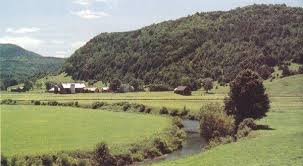How does abandoned farmland become a forest?
Abandoned Farm - First Year. A comumunity of crabgrass, insects and mice invades the field where corn or another crop once grew.
Second and Third Years. Tall weeds,such as asters, ragweed, and goldenrod, and tall grasses grow among the crabgrass. The crabgrass can´t easily survive in the shade cast by the taller weeds. It begins to die out. Rabbits and seed-eating birds move in.
Four to Six Years Later. The hot, dry field of tall weeds provides a perfect environment for pine seeds to sprout. Pine trees begin to grow and shade the weeds, which begin to die out. More birds join the community, as do small mammals like oposssums and skunks.
Twenty-Five Years Later. A pine forest has replaced the old farm field. Yet the number of new pine seedlings drops bacause they can´t grow in the shade. Seeds of deciduous trees such as maple, hickory, and oak sprout and take root. Larger animals like raccoons and foxes begin to visit.
One Humdred Years Later. The forest now mostly deciduous trees. These trees are the habitats of many different kinds of birds and small animals, such as squirrels. Deer, raccoons, and foxes also live in the forest.







